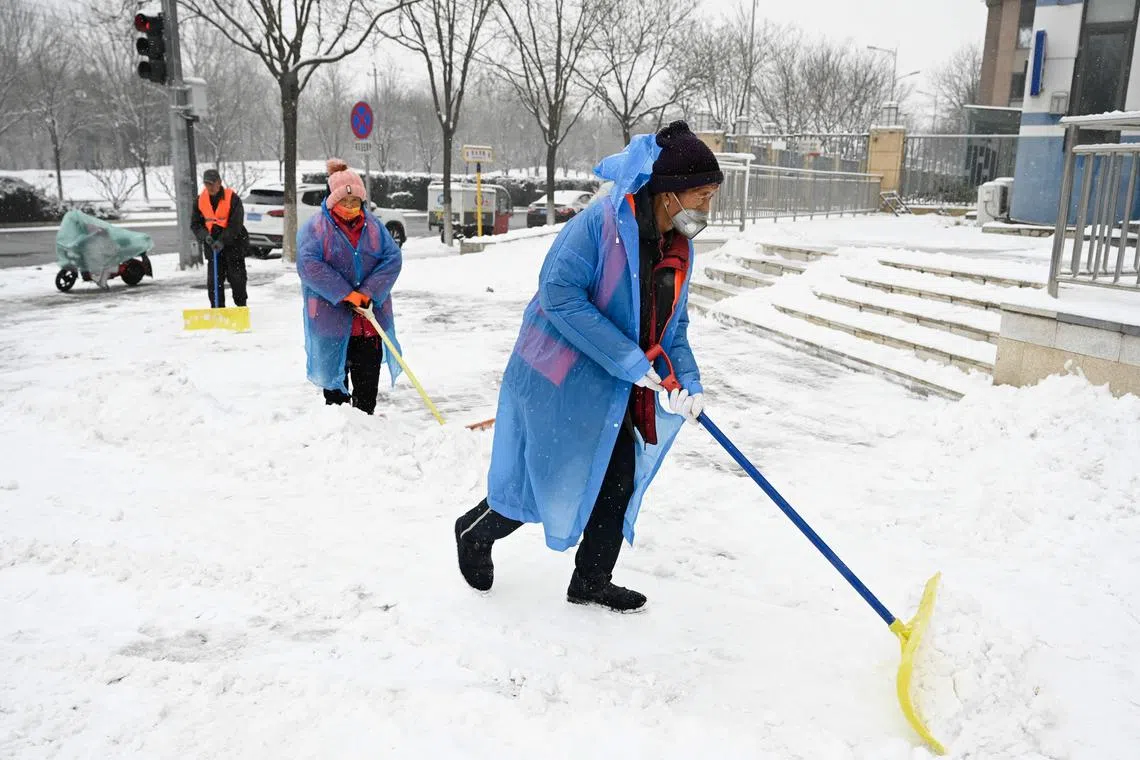Cold wave grips northern China, with south bracing itself for big chill
Sign up now: Get insights on Asia's fast-moving developments

People clearing snow from a pavement in Beijing on Dec 13.
PHOTO: AFP
Follow topic:
BEIJING – Cold weather gripped large swathes of China on Dec 14, with sharp falls in temperature expected over the next two days, particularly in the south, forecasters said, as the weather proves unusually frigid for December.
The cold snap is moving from several northern provinces hit by blizzards to central and southern areas such as the province of Guizhou, and pushing deep into the lower reaches of the Yangtze River delta.
The weather in Nanjing, the populous capital of Jiangsu province on the Yangtze’s southern banks near Shanghai, is expected to plunge to about 5 deg C from a mild 16 deg C over the next 24 hours.
“This cold wave is powerful. Later this week it will be a big move south,” said meteorological analyst Wang Weiyue, according to state broadcaster CCTV.
By Dec 17, temperatures south of the Yangtze could reach 0 deg C, while provinces just north of the Yellow River, such as Shandong, could see minus 10 deg C.
Further north, temperatures could approach historical lows for this time of the year or even surpass records, national weather forecasters warned.
In Beijing, snow has been building since Dec 11 in the capital of nearly 22 million. Temperatures are expected to further slide to minus 12 deg C on Dec 15 from about minus 3 deg C on Dec 14.
Major north-eastern cities, such as Shenyang and Harbin, could register as low as minus 27 deg C in what could be their lowest this year, CCTV said.
China has grappled with weather extremes this year, from ultra-low temperatures in January to record rainfall and a blistering hot summer, in wild swings that scientists blame on climate change.
This week, nearly 200 nations agreed at the COP28 climate summit
“These extreme weather (events) will become part of the normal experience moving into the future,” said Assistant Professor Li Yifei, an environmental studies specialist at New York University in the commercial hub of Shanghai.
“People need to be prepared individually because the chances of individuals being able to count on a government to provide for resources is becoming lower and lower.”

People play with snow amid snowfall in Beijing, China.
PHOTO: REUTERS
Temperatures were at a record low for a second straight day in several areas.
Snow and ice forced the closure of 126 highways across several provinces. Sleet and hail lashed central Henan. The cold forced closure of schools, with the provincial capital of Zhengzhou ordering home-schooling for younger children. It also suspended several train services.
Parents in Shaanxi to the north complained that lack of heating in a junior high school left children with frostbite on hands and feet.
Further east, in Shanxi, authorities raised the alert for cold waves to its highest, with temperatures expected to fall as low as minus 20 deg C by Dec 16 and even to minus 29 deg C in mountainous areas.
Temperatures in the provincial capital of Taiyuan averaged minus 4 deg C on Dec 14, with heavy snow forcing a three-hour closure of its international airport as workers de-iced the runway.

A worker operating a machine that sweeps away snow on a street in Beijing on Dec 14.
PHOTO: REUTERS
Severe icing on the grid led to an overnight power outage in Yuanqu, a city of nearly 200,000 to the south, spurring nearby cities and provinces to send emergency mobile power generator trucks.
Gale warnings also went out for far western Xinjiang, the west of Tibet, the Ningxia region, Qinghai province and parts of Inner Mongolia. REUTERS

